2020: A Disruptive Year For Weather Too
“There are two ways to be fooled. One, to believe what isn’t true. The other is to refuse to believe what is true” wrote 19th century Danish philosopher Soren Kierkegaard. The way 2020 is turning out it’s tempting not to believe our eyes or ears some days.
Meteorologists are paying attention to a firehose of freakish weather, tracking volcano-like plumes of smoke and ash from western fires. 140 mph wind gusts from an Iowa derecho. Hurricane Teddy hitting Nova Scotia, Canada! And now Paulette, a “zombie storm” that died, then regenerated over the eastern Atlantic. Back from the dead.
Make it stop, please.
A surge of 80-degree heat ignites a few T-storms later today with showers spilling into Thursday. Friday may be the last 80-degree day for some time. A risk of storms Friday night ushers in cooler, drier air for the weekend, which now looks a little nicer (and drier) than it did 24 hours ago.
A windblown surge of rain on Monday ushers much cooler air into town next week, with highs in the 50s – and a risk of jackets.
Tuesday afternoon visible image of Hurricane Teddy: NOAA and AerisWeather.
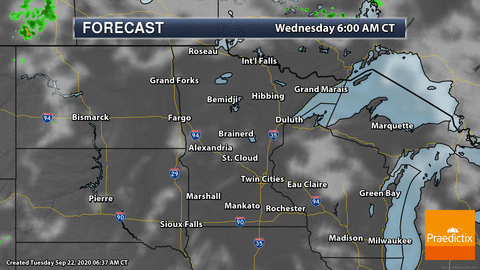
The Big Slide. No frost in store for the MSP metro yet, but jackets and sweatshirts stage a comeback next week. ECMWF suggests that daytime highs may not climb out of the 50s in the metro area the latter half of next week. MSP Meteogram: WeatherBell.

A Windier Than Average Summer Across Minnesota. Dr. Mark Seeley confirms our intuitions at Minnesota WeatherTalk: “…Looking at the climate data for May through August in the Twin Cities shows that 2020 did generally bring higher average daily wind speeds, and a higher than normal frequency of days with wind gusts over 30 mph. Only the month of July brought less than average daily wind speeds on most days. June was the windiest month of the summer and had 23 days with wind gusts over 30 mph. There were 21 days during the growing season when wind gusts exceeded 40 mph, and on August 10th and 14th wind gusts peaked briefly over 60 mph. These are indeed higher numbers and may partially be caused by the polar jet stream taking up position over the Minnesota landscape more frequently this summer...”

Ever Wonder Why Trees Ditch Their Leaves Every Fall? The Washington Post (paywall) has a good explainer geared toward kids; here’s an excerpt: “…Trees are solar-powered. Each leaf is loaded with a pigment called chlorophyll (pronounced CLORE-o-fill), which absorbs light and helps convert water and carbon dioxide into energy. The process is called photosynthesis (fo-toe-SYN-thuh-sis). But there’s a problem. In parts of the world that experience seasons, winter means less and less sunlight each day. It also comes with biting cold that can freeze the liquids inside leaves. These two factors hamper the tree’s ability to make energy. A full-grown oak tree might have more than 60,000 leaves, and each one requires valuable nutrients. So when fall turns into winter, trees discharge their leaves as a cost-cutting measure. If it had to spend resources on all those leaves through the winter, not only would the leaves freeze, but the tree would die...”
Praedictix Briefing: Issued Tuesday, September 22nd, 2020:
Tropical Storm Beta
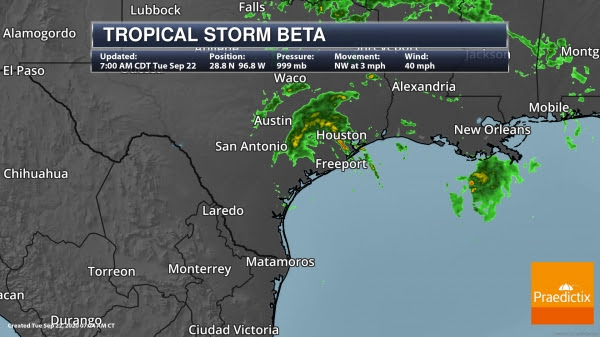
Beta Producing Heavy Rain Across Coastal Texas. Beta made landfall on the southern end of the Matagorda Peninsula last night around 10 PM and has continued to move farther inland overnight. This system is producing heavy rain across portions of Texas, with several one-day rainfall amounts of 6”+ around Houston. As of 7 AM CT, the center of Beta was located 10 miles east-southeast of Victoria, TX, or 35 miles west of Palacios, TX, moving northwest at 3 mph. Beta has sustained winds of 40 mph. Recently there was a sustained wind of 39 mph with a gust of 47 mph at Victoria.

Beta Track. While Beta is slowly moving this morning, it is expected to stall out inland over Texas today, slowly starting to move off to the east-northeast later tonight. The forward speed of Beta should increase as we head through the middle of the week, with Beta moving across portions of Louisiana and Mississippi late Wednesday through Friday. With Beta inland over Texas, we should see gradual weakening over the next few days with the system becoming a tropical depression by Wednesday morning and a remnant low in about two to three days.

Tropical Storm Warnings. Tropical Storm Warnings remain in place across portions of Texas this morning due to the potential of tropical storm force winds (39+ mph). Cities under Tropical Storm Warnings include Victoria, Bay City, Galveston, and Beaumont. Here are where warnings are in place along the coast:
A Tropical Storm Warning is in effect for…
* Port Aransas Texas to Sabine Pass
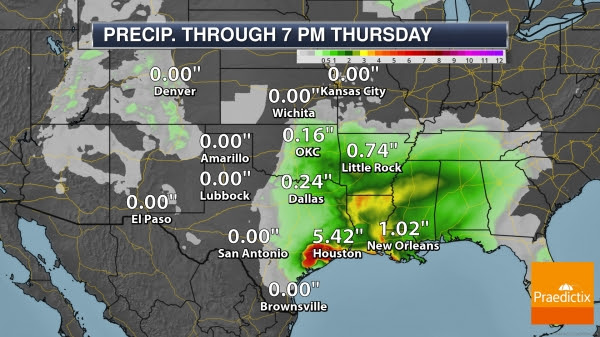
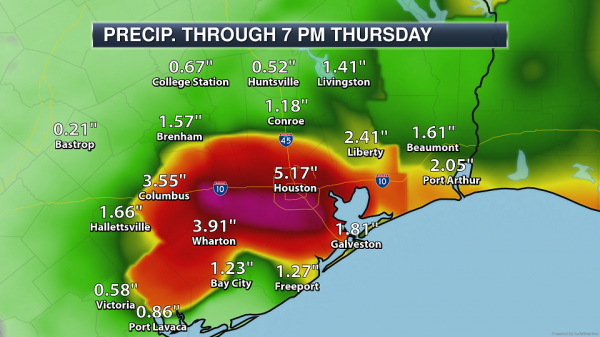
Heavy Rain. Heavy rain will continue to fall across the Deep South over the next few days as Beta eventually works off to the northeast. The heaviest additional rain totals are expected along the middle/upper Texas coast, with an additional 6-12” of rain leading to some storm totals of 20”. This will lead to significant flooding across the region. Elsewhere across portions of the lower Mississippi Valley and the Southeast rainfall totals of 3-5” are expected.

High Flooding Threat. As heavy rain has already fallen across the Texas Coast, with almost 7” of rain in the past day at Houston’s Hobby Airport, additional rain of at least 5-10” will lead to the potential of significant flash flooding along the upper Texas coast, particularly around the Houston metro. Due to this a High Risk of flash flooding is in place today. You can see a lesser flood threat move off to the east/northeast over the next few days.

Flood Watches. Due to the heavy rain threat, Flood Watches are in place from the mid-Texas coast to southern Louisiana.
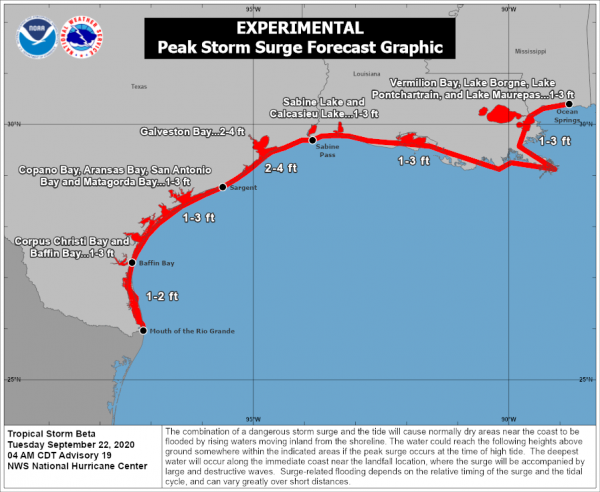

Storm Surge Threat. Coastal flooding and storm surge will continue to be a threat with Beta with Storm Surge Warnings from Sargent, TX, to Sabine Pass including Galveston Bay. The combination of the storm surge and tide will cause normally dry areas to be flooded by water moving inland from the Gulf of Mexico. The following levels could be reached if the peak surge occurs at high tide:
- Sargent, TX to Sabine Pass including Galveston Bay…2-4 ft
- Sabine Pass to Ocean Springs, MS including Sabine Lake, Calcasieu Lake, Vermilion Bay, Lake Borgne, Lake Pontchartrain, and Lake Maurepas…1-3 ft
- Baffin Bay, TX to Sargent, TX including Copano Bay, Aransas Bay, San Antonio Bay, Matagorda Bay, Corpus Christi Bay and Baffin Bay… 1-3 ft
- Mouth of the Rio Grande to Baffin Bay, TX…1-2 ft
Other Tropical Activity

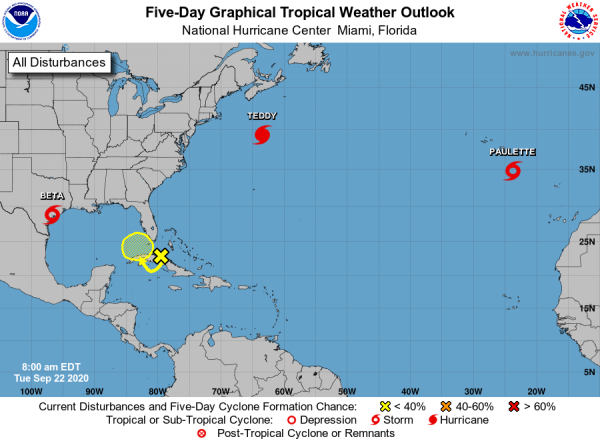
Other Tropical Activity. We are also watching the following systems in the Atlantic:
- Hurricane Teddy: Teddy is moving north-northwest this morning at 28 mph, heading for Atlantic Canada. On the current track, the center will move across eastern Nova Scotia Wednesday then over Newfoundland by Wednesday Night. Tropical Storm Warnings are in place for the south coast of Nova Scotia from Digby to Meat Cove, with Tropical Storm Watches from Meat Cove to Tidnish Nova Scotia, North of Digby to Fort Lawrence Nova Scotia, Magdalen Islands Quebec, Port aux Basques to Francois Newfoundland, and Prince Edward Island.
- Tropical Storm Paulette: Paulette has returned from the dead as a tropical storm southeast of the Azores. Paulette will continue to move to the east-northeast for the next day and a half before it turns back westward and becomes post-tropical.
- An area of showers and storms extends from the southeastern Bahamas west into Cuba and the southeastern Gulf of Mexico. It will move slowly move south today and tomorrow before moving back north through the end of the week. If development occurs (only a 10% chance in the next five days) it will be over the southeastern Gulf of Mexico late this week.
D.J. Kayser, Meteorologist, Praedictix
But Wait, There’s More. Hurricane Paulette hit Bermuda back on September 7, and then weakened as it passed over cold water. The core of the storm passed over warmer water west of Portugal, and now this disturbance has “regenerated” back into Tropical Storm Paulette. Welcome to zombie storms. It’s 2020, why not.
Summer of U.S. Disasters Set Records, Left Trail of Ruins. Bloomberg summarizes some of the biggest weather stories of 2020: “…Other parts of the U.S. saw record temperatures, too. Arizona, California, Colorado, Nevada, New Mexico and Utah all had their warmest August on record. Phoenix had its hottest month ever in August, with an average temperature of 99.1. And it was the hottest July ever across the Northern Hemisphere. Derechos: A line of violent storms known as a derecho cut electricity to more than 1 million customers last month in the U.S. Midwest and destroyed more than 550,000 acres of corn in Iowa. It was 160 miles (260 kilometers) wide, bringing lightning, hail and deadly, 100 mile-per-hour winds that cut a path of destruction across Iowa, Illinois and Indiana. It was one of the most damaging storms ever for Eastern Iowa’s power grid, leaving some areas without power for more than a week...”
File image above: NOAA.
Smoke from Western Fires Reported As Far Away as the Netherlands. Mental Floss has details: “For those not living in California, Oregon, or Washington, the raging wildfires in those states that have consumed more than 4 million acres might seem slightly abstract. But over the past week, the intensity of those blazes, coupled with specific weather patterns, has made it possible for people in New York—and even as far away in Europe as the Netherlands—to look up and see smoke in the skies. According to both NASA and the National Weather Service, jet streams have allowed the smoke to migrate across the Northeast and Mid-Atlantic regions, with the plume strong enough to actually blot out the sun and lower the temperature by a few degrees...”
Tuesday smoke visualization courtesy of NOAA.
The Limits of “Forest Management”. Can we do more to clear out brush and dead trees, less fuel to combust during a mega-fire? Absolutely. But other factors are in play, according to a story at The Washington Post: “…The scale of this year’s fires have horrified even those who saw them coming. As of Tuesday, 3.2 million acres in California have been incinerated — almost double the previous record of 1.9 million, set in 2018. In Oregon, blazes have erupted in parts of the wet Western Cascades that have not burned in years. On a single day last week, red-flag warnings on fire weather stretched along the entire West Coast from the U.S. border with Mexico to Canada. “It really is a shocking escalation,” said Daniel Swain, a climate scientist at the University of California at Los Angeles. “Characterizing it as a phase change, a new era of megafire — as dramatic as that sounds, ultimately I think it’s accurate…”
The Most Destructive Tornado in Minnesota History? Star Tribune follows up on a very good question: “…National Weather Service meteorologist Todd Krause noted that those tornadoes of a century ago tended to be more deadly because warning systems were rudimentary. Finally, if we consider property damage, the 1965 outbreak was the worst. Because it struck densely populated areas, it caused tens of millions of dollars in damage within a few hours. Some larger tornado systems may have caused more physical destruction, but fewer homes were lost because they took place in rural areas. The 1992 tornado system that hit Chandler, for example, spawned 27 total tornadoes. Even more were recorded on June 17, 2010, when 48 twisters walloped 22 counties, from Wadena to Albert Lea…”
Map credit:
How We Survive the Winter. A story at The Atlantic helps to set our expectations, and why the worst of the virus may be yet to come: “…Viruses travel differently in air of different temperatures and humidity levels. In typical summer weather, the microscopic liquid particles that shoot out of our mouths don’t travel as efficiently as they do in dry winter air. Cold weather also drives us inside, where air recirculates. “As things get colder, activities and people will start moving indoors, and unfortunately that’s going to increase transmission risk, and the risk of super-spreading events,” Tom Inglesby, the director of the Center for Health Security at Johns Hopkins, told me. The public-health directives that have allowed many businesses to reopen in recent months—by opening windows and doing as much as possible outdoors—will no longer be feasible in regions where temperatures plunge as the days grow short…”
File image: CDC.
Would You Be Willingly Blasted into Space for 10 Days? 10 days of sweet relief floating above the Earth (with no social media?) Yes please. CNN.com reports: “A planned reality show will seek to give the winner of its on-air competition “the greatest prize ever given out on Earth” — a 10-day stay on the International Space Station. The winning contestant on the show, called “Space Hero,” could launch into orbit as soon as 2023, the production company behind the proposed series, which is also called Space Hero...”
File NASA ISS image near Houston, Texas courtesy of Scott Kelly.
83 F. high in the Twin Cities on Tuesday.
69 F. average high on September 22.
69 F. high on September 22, 2019.
September 23, 1995: 0.2 inches of snow falls in the St. Cloud area.
September 23, 1985: Early snow falls over portions of Minnesota and western Wisconsin. Just under a half inch (0.4) is recorded at MSP Airport, mostly during the afternoon.
September 23, 1937: From summer to winter. The temperature was 101 at Wheaton. Then a cold front came through causing the mercury to tumble below freezing.
WEDNESDAY: Warm sun, late T-storms. Winds: S 10-15. High: 83
THURSDAY: Showers likely, rumble of thunder. Winds: E 7-12. Wake-up: 62. High: 75
FRIDAY: August’s last gasp? Stray storm late. Winds: S 10-20. Wake-up: 61. High: 83
SATURDAY: Partly sunny, cooler. PM shower risk. Winds: NW 10-15. Wake-up: 62. High: 76
SUNDAY: Mix of clouds and sunshine. Winds: NW 8-13. Wake-up: 55. High: near 70
MONDAY: Windblown rain showers, turning cooler. Winds: NW 20-35. Wake-up: 50. High: near 60
TUESDAY: Mostly cloudy, sweatshirt weather returns. Winds: NW 10-20. Wake-up: 47. High: 58
Climate Stories…
Walmart Sets Goal to Become Regenerative Company. Zero emissions by 2040. When the world’s largest retailer steps up and matches words with actions, maybe this is (another) inflection point. Here’s an excerpt from Walmart’s statement: “World’s largest retailer targets zero emissions by 2040 and aims to protect, manage or restore at least 50 million acres of land and one million square miles of ocean by 2030. Building on more than 15 years of sustainability leadership, Walmart today announced it is doubling down on addressing the growing climate crisis by targeting zero emissions across the company’s global operations by 2040. Walmart and the Walmart Foundation are also committing to help protect, manage or restore at least 50 million acres of land and one million square miles of ocean by 2030 to help combat the cascading loss of nature threatening the planet...”
Occupying Climate, Top 1% Pollute Twice As Much As Poorest 50%: Climate Nexus has headlines and links: “The world’s richest 1% are burning through the planet’s carbon budget at a staggering rate, doubling the combined carbon emissions of the poorest half of humanity over the past 25 years, a new report said Monday. The research, compiled by Oxfam and the Stockholm Environment Institute, blamed rich people’s increasing penchant for frequent air travel and driving SUVs and other high-polluting cars for their exorbitant share of humanity’s carbon pollution. The wealthy’s responsibility for the 60% increase in global carbon pollution over the last 25 years is also stark — the richest 1% are responsible for three times as much of that increase as the poorest half of humanity. The report’s findings highlight the necessity of wide-ranging systemic and international efforts to combat both climate change and inequality, its authors said. Individuals voluntarily acting alone “will never add up. This has to be driven by governments,” Tim Gore, head of climate policy for anti-poverty charity Oxfam and lead author of the report, told Reuters.” (Reuters, The Guardian)
File image: Climate Reality.
RPG’s Death Leaves Climate-Shaped Hole in the Supreme Court. Grist provides perspective: “…Appointed to the Supreme Court by Bill Clinton in 1993, Ginsburg often ruled in favor of stronger environmental protections. For many years, she was the closest thing the Supreme Court had to a climate hawk, especially compared to some of her fellow justices, like Republican appointees Clarence Thomas and Samuel Alito. Her many votes in favor of stricter environmental protections were a boon to green groups and blue states. Over her 27 years on the high court, a few of her most meaningful legal contributions were related to the greenhouse gas emissions fuel climate change — specifically, who between states, private companies, and the federal government, was responsible for regulating them. Looking at several opinions, Ginsburg seemed to have a clear point of view...”
File image: Duke University.
GE Plans to Stop Making Coal-Fired Power Plants. Nail, meet coffin. Here’s an excerpt from Reuters: “…GE has said in the past it would focus less on fossil fuels and more on renewable energy, reflecting a growing acceptance of clean power sources by utilities. “GE’s exit from building new coal-fired power — after decades as a leader in this space — is an acknowledgement that growth in the energy sector will no longer be in coal,” said Kathy Hipple, a financial analyst at Institute for Energy Economics and Financial Analysis. “The market will ultimately reward GE for exiting new coal builds...”
White House Recommends Ryan Maue, Meteorologist and Critic of Dire Climate Predictions, for NOAA Chief Scientist. Capital Weather Gang explains: “…Maue serves as the developer of weathermodels.com, a site that displays computer model information using eye-catching graphics to make their simulations accessible to professionals and hobbyists. He was previously an adjunct scholar with the Cato Institute, a libertarian think tank that was involved in efforts to question the scientific consensus on human-induced climate change. Along with Patrick Michaels, a well-known climate change contrarian, Maue penned a 2018 op-ed in the Wall Street Journal challenging the climate change projections made in 1988 by noted former NASA scientist James Hansen, which other researchers, backed up by peer-reviewed studies, have found were prescient...”
Every Place Has It’s Own Climate Risks. What Is It Where You Live? It turns out semantics matter. Here’s an excerpt from an Op-Ed at The New York Times (paywall): “…The solution may be found in research showing that addressing climate change in emotional and personal terms is far more persuasive. “There is a lot of evidence behind the idea that personalizing climate change and helping people understand the local impacts are more important than talking about how it’s influencing melting glaciers or talking about wildfires when you live in Ohio,” said Jennifer Marlon, a research scientist and lecturer at Yale. The idea of a climate rebranding gained new attention this week after Gov. Jay Inslee of Washington told reporters: “These are not just wildfires. They are climate fires…”
Map credit: “Note: “Water stress” reflects the change in drought-like conditions as well as water demand. The methodology does not consider distant water supply, so in counties where that may play a larger role, we have selected the second-highest climate risk. Risk levels reflect climate impacts from today to 2040. The “wildfire” label applies to counties where at least part of the region contains the highest risk rating in Four Twenty Seven’s data. Other terms are assigned using the highest percentile scores among the remaining climate risks.” Source: Four Twenty Seven.
Arctic Sea Ice. An update from Climate Central: “Arctic sea ice likely reached its minimum extent for the year, 1.44 million square miles, on September 15. The 2020 minimum is the second lowest in the nearly 42-year satellite record according to the National Snow and Ice Data Center (NSIDC). That extent is about 46% of the area of the 48 contiguous states. A Siberian heat wave began this year’s Arctic sea ice melt season early, and with Arctic temperatures 14°F to 18°F warmer than average, the ice kept melting. Arctic ice loss is leading to a reinforcing heat spiral. When ice melts and exposes the open ocean, the darker ocean surface absorbs more heat, which then leads to more ice loss, continuing the feedback loop. This contributes to the Arctic regions warming twice as fast as the rest of the planet...”
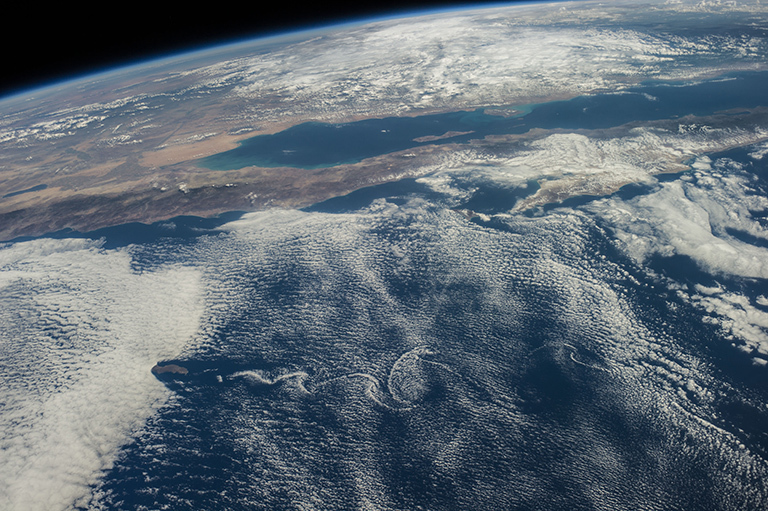
Meet the Man Who Told Trump Climate Change is Real. Speaking truth to power? Here’s an excerpt from Science AAAS: “…Crowfoot, 47, runs California’s Natural Resources Agency and oversees 19,000 employees and multiple agencies. His decision to challenge Trump was spontaneous. “I didn’t plan to beforehand,” Crowfoot said an interview. “I don’t know if it was instinct, or just the intellectual curiosity of actually trying to have a conversation with him on it,” he added. There were multiple points to make on the fires, Crowfoot said, but he believed “the most important conversation to engage him in was climate change.” On the president’s response—regarding climate scientists not knowing about rising temperatures—Crowfoot said he felt “disappointed but perhaps not surprised.” The discussion marked a rare occasion on which Trump received pointed—and accurate—information about climate change...”
File photo of Baja California: NASA.
The Carbon Footprint Sham. When is a corporation’s motives and tactics appropriate and authentic vs. a well-oiled case of greenwashing? Here’s an excerpt from Mashable: “…Doyle concludes BP sought to explain what a carbon footprint is “in a way which assigns responsibility for climate impact to the individual, while BP registers its own concerns by appearing already to be doing something about it.” Yet in a society largely powered by fossil fuels, even someone without a car, home, or job will still carry a sizable carbon footprint. A few years after BP began promoting the “carbon footprint,” MIT researchers calculated the carbon emissions for “a homeless person who ate in soup kitchens and slept in homeless shelters” in the U.S. That destitute individual will still indirectly emit some 8.5 tons of carbon dioxide each year...”
Graphic credit: CO2 levels for the last 800,000 years courtesy of NASA.

Geoengineering is the Only Solution to Our Climate Calamities. God help us if it gets to this point, because really, what could possibly go wrong? Here’s an excerpt of an Op-Ed at WIRED.com (paywall): “…The environmental “Manhattan Project” we need would also require pooling together the innovation and resources of Bill Gates, who has invested billions in concentrated solar power and fusion reactors, Elon Musk, who has nearly single-handedly created the supply and the demand for a commercially viable market for electric vehicles, and potentially Jeff Bezos, whose Earth Fund is directing at least $10 billion towards climate initiatives, as well as other tech visionaries and the research organizations they support. Hopefully, today’s climate protagonists are already working to launch a range of geoengineering schemes, even if they have to do so in secret, shielded from climate-change-denying politicians and interest groups masquerading in the name of democratic accountability. Governments and environmental advocates are right to demand that all organizations involved in geoengineering transparently disclose their funding, objectives, and results on sites such as Geoengineering Monitor...”
File image: NASA.


